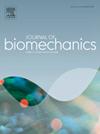Machine-based based subtalar pronator and supinator strength training increases rearfoot stability in male runners
IF 2.4
3区 医学
Q3 BIOPHYSICS
引用次数: 0
Abstract
Excessive pronation and increased pronation velocity of the foot due to excessive Subtalar Joint (STJ) motion have been discussed as major intrinsic factors for the pathophysiology of overuse running injuries. A possible strategy to reduce these risk factors is the use of the supinator muscles acting eccentrically during the support phase of running. We hypothesised that STJ-specific strength training of the supinator and pronator muscles would be more effective in reducing rearfoot motion compared to traditional plantarflexor and dorsiflexor exercises.
Twenty healthy male (20–35 years) recreational runners performed machine-based Subtalar Training (ST) with the right foot and machine-based plantar-/ dorsiflexor taining around the Talocrural joint (TT) with the left over a period of ten weeks. STJ muscle strength and shank muscle volume were measured in pre- and posttest. Furthermore, rearfoot motion during overground running (3.3 m/s) was analysed.
The multifactorial analyses showed significant increases in muscle strength and volume (p < 0.001). Interaction effects (time x group) revealed higher strength increases for ST (p < 0.001) and higher muscle volume increase in the deep supinator muscles (p < 0.05) for ST. The analyses of rearfoot motion showed significant changes after the treatment indicated by a higher inversion angle at touchdown (p < 0.01) and reduced eversion velocity in mid-stance (p < 0.01). Both effects were higher after ST (p < 0.01; time x group interaction).
Machine-based subtalar-specific strength training represents a potential prevention strategy for male runners to enhance the function of the supinator muscles, to stabilise rearfoot motion during running and, therefore, to reduce lower limb injury risk.
基于机器的距下旋前肌和旋后肌力量训练可以提高男性跑步者的后脚稳定性
过度的距下关节(STJ)运动导致足部过度旋前和旋前速度增加被认为是过度跑步损伤病理生理学的主要内在因素。减少这些危险因素的一个可能的策略是在跑步的支撑阶段使用偏心作用的旋后肌。我们假设,与传统的跖屈肌和背屈肌训练相比,stj特异性的旋后肌和旋前肌力量训练在减少后脚运动方面更有效。20名健康男性(20-35岁)的休闲跑步者在10周的时间里,用右脚进行基于机器的距下训练(ST),用左脚进行基于机器的足底/背屈肌围绕Talocrural关节(TT)的训练。测试前后分别测量STJ肌力量和小腿肌体积。进一步分析了3.3 m/s地上跑时的后脚运动。多因素分析显示肌肉力量和体积显著增加(p <;0.001)。相互作用效应(时间x组)显示ST (p <;0.001),深旋后肌的肌肉体积增加(p <;治疗后的后足运动分析显示,在触地时较高的倒角表明治疗后后足运动发生了显著变化(p <;0.01),中位外翻速度降低(p <;0.01)。两种效应在ST后都更高(p <;0.01;时间x小组互动)。对于男性跑步者来说,基于机器的距下特定力量训练是一种潜在的预防策略,可以增强旋后肌的功能,在跑步过程中稳定后脚运动,从而降低下肢受伤的风险。
本文章由计算机程序翻译,如有差异,请以英文原文为准。
求助全文
约1分钟内获得全文
求助全文
来源期刊

Journal of biomechanics
生物-工程:生物医学
CiteScore
5.10
自引率
4.20%
发文量
345
审稿时长
1 months
期刊介绍:
The Journal of Biomechanics publishes reports of original and substantial findings using the principles of mechanics to explore biological problems. Analytical, as well as experimental papers may be submitted, and the journal accepts original articles, surveys and perspective articles (usually by Editorial invitation only), book reviews and letters to the Editor. The criteria for acceptance of manuscripts include excellence, novelty, significance, clarity, conciseness and interest to the readership.
Papers published in the journal may cover a wide range of topics in biomechanics, including, but not limited to:
-Fundamental Topics - Biomechanics of the musculoskeletal, cardiovascular, and respiratory systems, mechanics of hard and soft tissues, biofluid mechanics, mechanics of prostheses and implant-tissue interfaces, mechanics of cells.
-Cardiovascular and Respiratory Biomechanics - Mechanics of blood-flow, air-flow, mechanics of the soft tissues, flow-tissue or flow-prosthesis interactions.
-Cell Biomechanics - Biomechanic analyses of cells, membranes and sub-cellular structures; the relationship of the mechanical environment to cell and tissue response.
-Dental Biomechanics - Design and analysis of dental tissues and prostheses, mechanics of chewing.
-Functional Tissue Engineering - The role of biomechanical factors in engineered tissue replacements and regenerative medicine.
-Injury Biomechanics - Mechanics of impact and trauma, dynamics of man-machine interaction.
-Molecular Biomechanics - Mechanical analyses of biomolecules.
-Orthopedic Biomechanics - Mechanics of fracture and fracture fixation, mechanics of implants and implant fixation, mechanics of bones and joints, wear of natural and artificial joints.
-Rehabilitation Biomechanics - Analyses of gait, mechanics of prosthetics and orthotics.
-Sports Biomechanics - Mechanical analyses of sports performance.
 求助内容:
求助内容: 应助结果提醒方式:
应助结果提醒方式:


